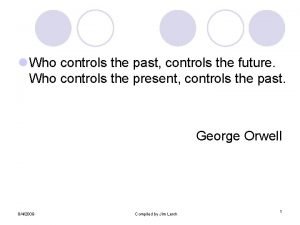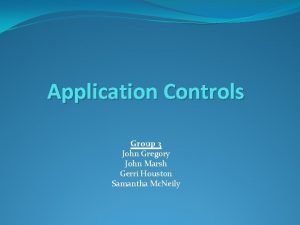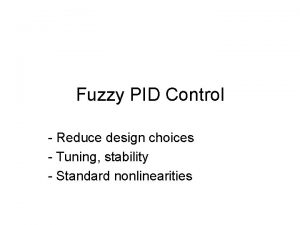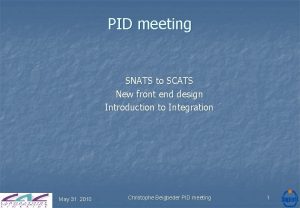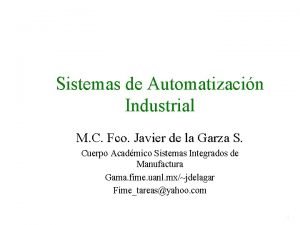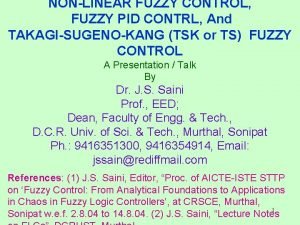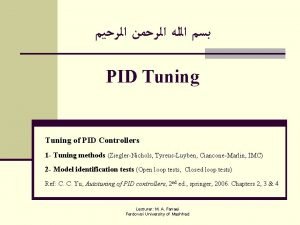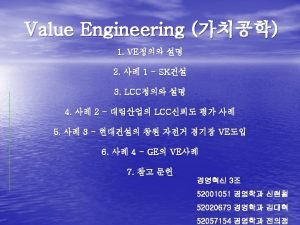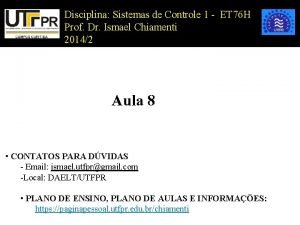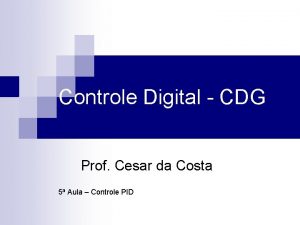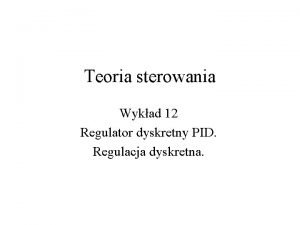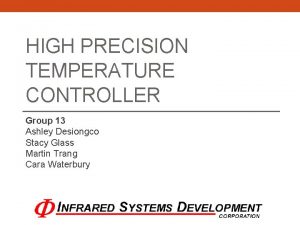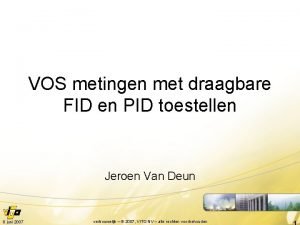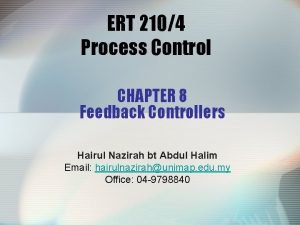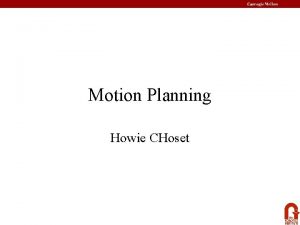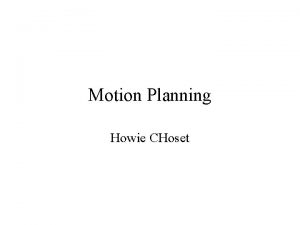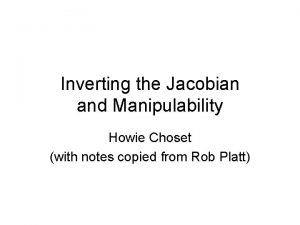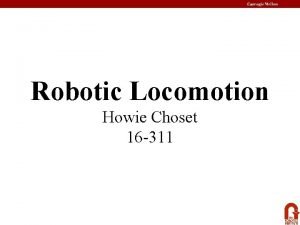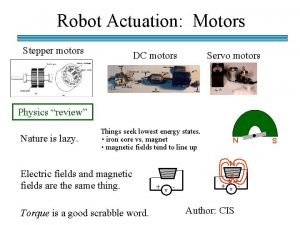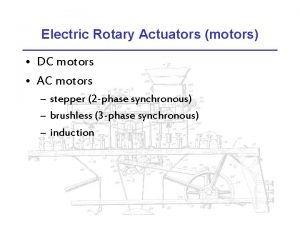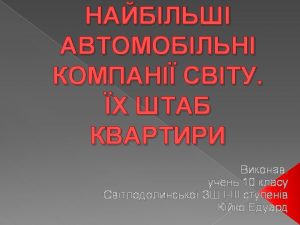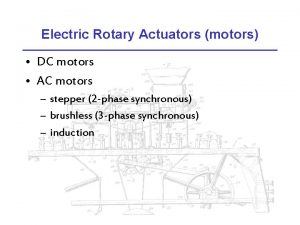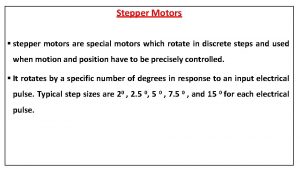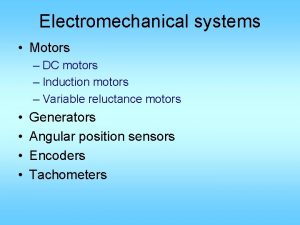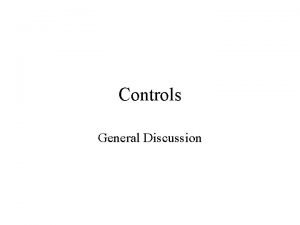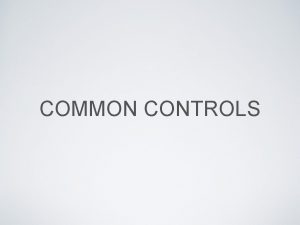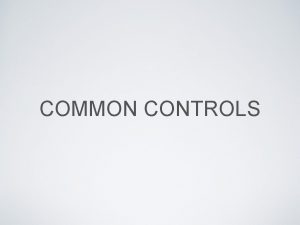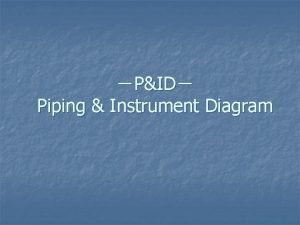PID Controls of Motors Howie Choset thanks to



![Review of Motor Model • electric inductance (L) = [H] (VL = L di/dt) Review of Motor Model • electric inductance (L) = [H] (VL = L di/dt)](https://slidetodoc.com/presentation_image_h2/5de74d6a9aec5d60136f1fd53c312710/image-4.jpg)


















- Slides: 22

PID Controls of Motors Howie Choset (thanks to Gary Fedder) http: //www. library. cmu. edu/ctms/examples/motor. htm

Controls • • • Review of Motor Model Open Loop (controller-free) Response Proportional Control – Stable – Faster Response = Bigger Overshoot – Steady State Error • PI Control – Maintain Stability – Decrease Steady State Error = Bigger Overshoot • PID Control – Derivative term reduces overshoot, settling time • Feed Forward – Overcome damping

Mass-Spring-Damper Model (Analogy) Model of mass spring damper system z(t) position, z(t) velocity t 0 initial time, z(t 0) initial position & velocity
![Review of Motor Model electric inductance L H VL L didt Review of Motor Model • electric inductance (L) = [H] (VL = L di/dt)](https://slidetodoc.com/presentation_image_h2/5de74d6a9aec5d60136f1fd53c312710/image-4.jpg)
Review of Motor Model • electric inductance (L) = [H] (VL = L di/dt) * input (V): Source Voltage * output (theta): position of shaft * The rotor and shaft are assumed to be rigid • moment of inertia of the rotor (J) [kg. m^2/s^2] * damping ratio of the mechanical system (b) [Nms] * electromotive force constant • Ke is volt (electromotive force) per radians per second (V/ rad/sec) • torque constance • Kt is torque amp (Nm/Amp) * electric resistance (R) = [ohm]

Review of Motor Model Torque is proportional to current (Lenz’s Law) Back emf is proportional to motor speed (Faraday’s Law) Mechanical Equation of Motion Assume (K=Ke=Kt) Electrical Equation of Motion Solve for sq/V

Transfer Function of Motor (with Approximations). = Open Loop Transfer Function = Can rewrite function in terms of an electrical and mechanical behavior . Electrical time constant on motor is much smaller example motor with equivalent time constants . = For small motors, the mechanical behavior dominates (electrical transients die faster).

Open Loop Response (to a Step) • Apply constant voltage • Slow response time (lag) • Weird Apples-to-Orange relationship between input and output – If you want to set speed, what voltage do you input? – Weird type of steady state error • No reaction to perturbations Input Voltage Plant Output Speed

Closed Loop Controller Give it a velocity command get a velocity output Ref + error - Controller voltage Controller Evaluation Steady State Error Rise Time (to get to ~90%) Overshoot Settling Time (Ring) (time to steady state) Stability Plant

Close the loop analogy

Stability Asymptotic Stability:

Closed Loop Response (Proportional Feedback) Proportional Control Easy to implement Input/Output units agree Improved rise time Steady State Error (true) P: Rise Time vs. Overshoot P: Rise Time vs. Settling time R + error - Voltage = Kp error Controller voltage Plant

Closed Loop Response (PI Feedback) Proportional/Integral Control No Steady State Error Bigger Overshoot and Settling Saturate counters/op-amps P: Rise Time vs. Overshoot P: Rise Time vs. Settling time I: Steady State Error vs. Overshoot Ref + error - Voltage = (Kp+1/s Ki) error voltage Plant

Closed Loop Response (PID Feedback) Proportional/Integral/Differential Quick response Reduced Overshoot Sensitive to high frequency noise Hard to tune P: Rise Time vs. Overshoot P: Rise Time vs. Settling time I: Steady State Error vs. Overshoot D: Overshoot vs. Steady State Error R + error - Voltage = (Kp+1/s Ki + s. Kd) error voltage Plant

Feed Forward Volt Decouples Damping from PID To compute Try different open loop inputs and measure output velocities For each trial i, Tweak from there. . R + error - + volt + Controller Plant

Follow a straight line with differential drive Error can be difference in wheel velocities or accrued distances Make both wheels spin the same speed asynchronous – false start wheels can have slight differences (radius, etc) Make sure both wheels spin the same amount and speed false start More complicated control laws – track orientation m 1 vref = vref + K 1 * thetaerror + K 2 * offset error modeling kinematics of robot dead-reckoning

Encoders

Encoders – Incremental Photodetector Encoder disk LED Photoemitter

Encoders - Incremental

Encoders - Incremental • Quadrature (resolution enhancing)

Where are we? • If we know our encoder values after the motion, do we know where we are?

Where are we? • If we know our encoder values after the motion, do we know where we are? • What about error?

Encoders - Absolute § More expensive § Resolution = 360° / 2 N where N is number of tracks 4 Bit Example
 Multi loop pid controller regolatore pid multi loop
Multi loop pid controller regolatore pid multi loop Diane howie
Diane howie Sarah howie
Sarah howie He who controls the past controls the future
He who controls the past controls the future General controls vs application controls
General controls vs application controls Pid
Pid Pid meeting
Pid meeting “control de grua” and pid
“control de grua” and pid Hlyniany
Hlyniany Pid contrl
Pid contrl Open office
Open office Pid et pfd
Pid et pfd Controle pid
Controle pid Calculo pid
Calculo pid Pid dyskretny
Pid dyskretny Pid identifier
Pid identifier Pid
Pid Pid meter werking
Pid meter werking Pid grading
Pid grading Pid discharge pictures
Pid discharge pictures Pid xing
Pid xing The controllers chapter 8
The controllers chapter 8 Pid schematics
Pid schematics



